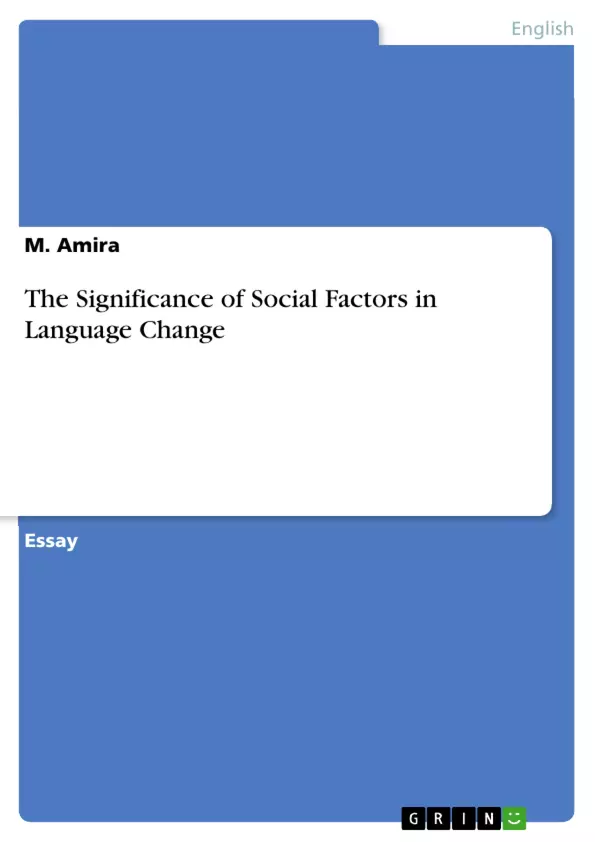While perspectives towards the phenomenon of language change are various and partly contradictory, they all coincide in the overall question of why and how language change takes place. In order to address this question, it is important to first, position the phenomenon of language change within the two major perspectives in linguistics, that is the distinction between linguistic change as diachronic or synchronic variation. Next, different models and theories that try to explain the origin of change and its underlying mechanism such as the family tree or wave model can be consulted in order to gain an insight into the complexity and interrelatedness of the different approaches.
Especially the notion of internally and externally motivated change is here of special importance. In addition, these models prove to be foundational for the further discourse on how language change spreads and under which influences. Keeping this in mind, a closer look at the synchronic perspective of sociolinguistics provides relevant knowledge about the role of social factors in causing linguistic change which finally enables a testing of this perspective on the basis of the case examples of linguistic change in "Martha’s Vineyard" (Blake & Josey, 2003) and "Ucieda" (Holmquist, 1985). In essence, this essay will examine the relationship between diachronic and synchronic approaches towards language change and demonstrate the significance of social factors on the basis of different theories and examples.
Inhaltsverzeichnis (Table of Contents)
- Introduction
- Language Change in Linguistic Theory: Approaches, Theories & Examples
- Perspectives on Language Change
- Models and Theories on Language Change
- How Language Change spreads
- Social Factors and Dimensions involved in Language Change
- Testing the Sociolinguistic Approach of Language Change
- Language Change in Ucieda and Martha's Vineyard
- Analysis
Zielsetzung und Themenschwerpunkte (Objectives and Key Themes)
This essay explores the phenomenon of language change from both diachronic and synchronic perspectives, analyzing how it originates and spreads, and examining the significant role of social factors in driving linguistic evolution.
- Understanding the distinction between diachronic and synchronic approaches to language change.
- Examining different models and theories that explain the origins and mechanisms of language change, such as the family tree and wave models.
- Investigating the role of internal and external factors in driving linguistic change, including linguistic and social motivations.
- Exploring how language change spreads within and across speech communities.
- Analyzing the influence of social factors such as status, prestige, gender, identity, and interaction on linguistic change.
Zusammenfassung der Kapitel (Chapter Summaries)
- Introduction: This chapter sets the stage for the essay by introducing the central question of why and how language change occurs. It highlights the importance of understanding the distinction between diachronic and synchronic perspectives on language change and outlines the key themes explored in the following chapters.
- Language Change in Linguistic Theory: Approaches, Theories & Examples: This chapter delves into different perspectives on language change, exploring the traditional diachronic approach and its focus on internally and externally motivated change. It examines how sociolinguistics offers a synchronic view of language change, emphasizing the role of social factors.
- Models and Theories on Language Change: This chapter introduces key models and theories that aim to explain the origins and workings of language change, including the family tree model and the wave model. It discusses the distinction between internal and external changes and their implications for understanding linguistic evolution.
- How Language Change spreads: This chapter explores various theories related to how language change spreads within a community, including the wave metaphor and the process of linguistic simplification. It emphasizes the importance of considering social factors alongside linguistic processes.
- Social Factors and Dimensions involved in Language Change: This chapter examines the role of social factors in driving linguistic change. It explores the influence of social status, prestige, gender, identity, and interaction, highlighting the use of the apparent-time method in studying age-related changes.
Schlüsselwörter (Keywords)
The key focus of this essay lies in the exploration of language change, analyzing its diachronic and synchronic perspectives, as well as the role of social factors in driving linguistic change. This includes concepts like the family tree and wave models, internal and external motivations, social status, prestige, and the apparent-time method.
- Quote paper
- M. Amira (Author), 2021, The Significance of Social Factors in Language Change, Munich, GRIN Verlag, https://www.hausarbeiten.de/document/1330382


